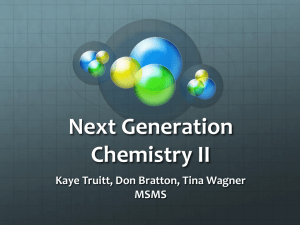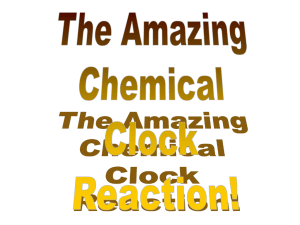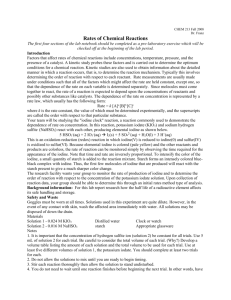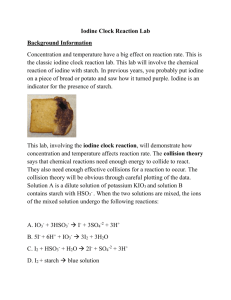Kineticslesson - WordPress.com
advertisement
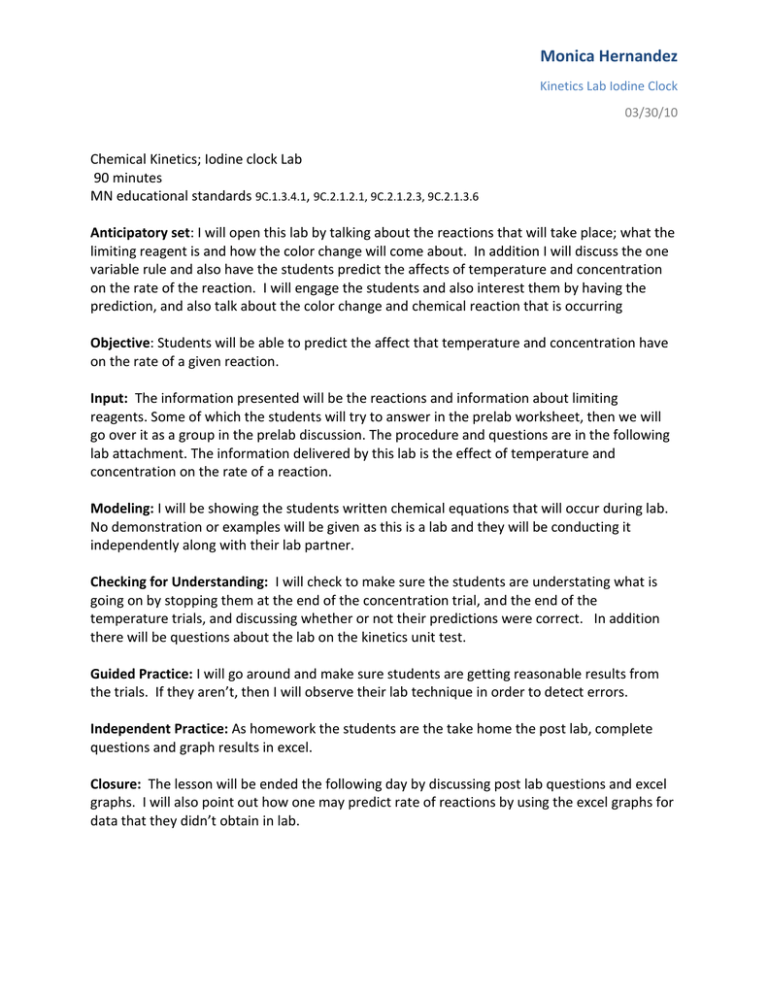
Monica Hernandez Kinetics Lab Iodine Clock 03/30/10 Chemical Kinetics; Iodine clock Lab 90 minutes MN educational standards 9C.1.3.4.1, 9C.2.1.2.1, 9C.2.1.2.3, 9C.2.1.3.6 Anticipatory set: I will open this lab by talking about the reactions that will take place; what the limiting reagent is and how the color change will come about. In addition I will discuss the one variable rule and also have the students predict the affects of temperature and concentration on the rate of the reaction. I will engage the students and also interest them by having the prediction, and also talk about the color change and chemical reaction that is occurring Objective: Students will be able to predict the affect that temperature and concentration have on the rate of a given reaction. Input: The information presented will be the reactions and information about limiting reagents. Some of which the students will try to answer in the prelab worksheet, then we will go over it as a group in the prelab discussion. The procedure and questions are in the following lab attachment. The information delivered by this lab is the effect of temperature and concentration on the rate of a reaction. Modeling: I will be showing the students written chemical equations that will occur during lab. No demonstration or examples will be given as this is a lab and they will be conducting it independently along with their lab partner. Checking for Understanding: I will check to make sure the students are understating what is going on by stopping them at the end of the concentration trial, and the end of the temperature trials, and discussing whether or not their predictions were correct. In addition there will be questions about the lab on the kinetics unit test. Guided Practice: I will go around and make sure students are getting reasonable results from the trials. If they aren’t, then I will observe their lab technique in order to detect errors. Independent Practice: As homework the students are the take home the post lab, complete questions and graph results in excel. Closure: The lesson will be ended the following day by discussing post lab questions and excel graphs. I will also point out how one may predict rate of reactions by using the excel graphs for data that they didn’t obtain in lab. Monica Hernandez Kinetics Lab Iodine Clock 03/30/10 Pre Lab - 1. If we need to make a 0.024M KIO3 (Potassium Iodate ) solution, how many grams of KIO3- would need to be added to 1L of water? 2. If we add 1.7g of NaHSO3 to 1L of water what is the molarity of the solution? Monica Hernandez Kinetics Lab Iodine Clock 03/30/10 SAFETY OVERVIEW The Iodine Clock Reaction is a “classic” experiment demonstrating the effects of concentration and temperature on reaction rate. In this experiment two solutions are mixed. The reaction takes place in two steps. Step 1: IO3- (aq) + 3HSO3- (aq) → I-(aq) +3SO42- (aq) + 3H+(aq) Step 2: 5I-(aq) + 6H+(aq) + IO3-(aq) → 3I2(aq) + 3H2O(l) The iodine, I2, produced in Step 2 will react with starch (not shown in the equations), producing a deep blue-black solution. The rate of the entire reaction can be measured by timing how long it takes before the blue color appears once the two solutions are mixed. By altering the concentration of one of the reactants (Part A) and by changing the reaction temperature (Part B), the effects of these factors on reaction rate can be determined. PURPOSE To measure the rate of a reaction. To measure the effect of changing reactant concentration on reaction rate. To measure the effect of changing temperature on reaction rate Avoid getting either solution on your skin or clothes. Wash any splashes with cold water. Wear safety goggles EQUIPMENT AND MATERIALS Solution A (contains IO3- ions) Solution B (contains HSO3- & starch) distilled water ice cubes beakers, 250 mL and 100 mL (2) graduated cylinders, 10 mL (2) LARGE test tubes (2) thermometer water baths timer (stop watch or clock with second hand) safety goggles magnetic stirrer, optional PROCEDURE Part A. Effect of Concentration 1. For Trial 1 measure exactly 10.0 mL of solution A and pour into a 100 mL beaker 2. Use a different graduated cylinder to measure exactly 10.0 mL of solution B and pour it into a second 100 mL beaker 3. You will begin recording reaction time as soon as you first mix the two solutions. One person should record the time of reaction while the other partner mixes the solutions. Pour one of the solutions into the other, then pour the solutions back and forth sever times to ensure thorough mixing. Then wait for the completion of the reaction. 4. Record the time at the instant the deep blue-black color first appears. Monica Hernandez Kinetics Lab Iodine Clock 03/30/10 5. You will repeat Steps 1 – 4 using different concentrations of solution A. Obtain the dilutions by adding distilled water to Solution A, according to the following table: Trial Solution A Distilled (mL) Water 1 10.0 0.0 2 9.0 1.0 3 8.0 2.0 4 7.0 3.0 5 6.0 4.0 6 5.0 5.0 7 4.0 6.0 8 3.0 7.0 Rinse and dry the beakers and graduated cylinders between each trial to avoid contamination/early mixing of reactants. If time is short, half the class may be assigned trials 2, 4, 6, 8 and the other half should do trials 3, 5, 7. All groups should do the 1st trial. At the end of the lab data should be shared between groups. Part B. Effect of Temperature 1. You will follow the same procedure as you used for Trial 1 of Part A, mixing 10.0 mL of Solution A with 10.0 mL of Solution B. The concentrations will be kept constant, but you will vary the temperature of the solutions before mixing. As with Part A, different groups of students may be assigned different temperatures. 2. Class data should be obtained for the following temperatures. Each group of students should do trials at four temperatures: Set 1: 5°C 15°C 25°C 35°C Set 2: 10°C 20°C 30°C 40°C 3. Prepare water baths for your set of solutions. Fill a 250 mL beaker about two third full with water of the appropriate temperature. For water baths below room temperature, use ice to chill the water. For warmer baths use warm water from the tap or a kettle. There should be enough water in the beakers so that the solutions in the test tubes are well beneath the water level in the baths. 4. As before, measure out exactly 10.0 mL of Solution A and B, pouring each into their own test tube. Place the two test tubes in your water baths, allowing them to remain for about 10 minutes to allow the solution temperatures to reach the temperature of the water baths. Use the thermometer to monitor water bath temperatures. Try to keep the water bath temperature within 0.5°C of your assigned temperature. Add more ice or warm water as necessary. Record your water bath temperature just before mixing the solutions in the data table. 5. Once the solutions are at the desired temperatures, prepare to record time and mix the two solutions. Pour the mixture back and forth between the two test tubes several times to ensure mixing. Then place the test tube containing the mixed solutions back in the water bath. Record the time it takes from initial mixing until the deep blue-black color appears. At the end of the lab, share temperature and reaction rate data between groups. Monica Hernandez Kinetics Lab Iodine Clock 03/30/10 RESULTS Conclusions and Questions Results may be recorded in the following data tables. Part A. Effect of Concentration Trial 1 2 3 4 5 6 7 8 Trial Volume KIO3 (mL) Distilled Water (mL) 10.0 9.0 8.0 7.0 6.0 5.0 4.0 3.0 0.0 1.0 2.0 3.0 4.0 5.0 6.0 7.0 Time to Completion (s) 1 2 3 4 5 6 7 8 Solution Temperature (°C) 2. Based on your results what can you conclude regarding the effect of concentration on reaction rate? Use the collision theory to explain this effect. 3. Based on your results what conclusion can you make regarding the effect of temperature on reaction rate? Explain this in terms of the collision theory. Part B. Effect of Temperature Trial 1. Using Excel plot your results for Part A and Part B on two graphs. Graph A – plot mL Solution A vs reaction time Graph B – plot Temperature vs reaction time Time to Completion (s) Monica Hernandez Kinetics Lab Iodine Clock 03/30/10 Teachers Lab Guide Kinetics Lab AP Chemistry Iodine Clock Reaction Solutions: A- 0.024M KIO3- (Potassium Iodate ) Weigh 5.1g of KIO3- (solid) and mix with 1 L of water. Sake vigorously until dissolved. B- 0.016M NaHSO3 (Sodium Bissulfite) and 1% starch In large beaker heat .5-1L of water to a boil. Add 10g of Starch (soild). Stir until dissolved. Weigh 1.7g of NaHSO3 and add to starch solution. Add enough water to make 1 L. Note to students that the color change of the mixture of solutions A and B will happen rapidly. (Less than 1 second) It will not be difficult to notice the color change so be ready with your timing device.
